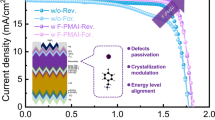Abstract
The work function (WF) of indium-tin-oxide (ITO) substrates plays an important role on the inverted organic photovoltaic device performance. And electrode engineering has been a useful method to facilitate carrier extraction or charge collection to enhance organic photovoltaic (OPV) performance. By using self-assembly technique, we have deposited poly(dimethyl diallylammonium chloride) (PDDA) layers onto ITO coated glass substrates. The results indicate that the surface WF of ITO is reduced by about 0.3 eV after PDDA modification, which is attributed to the modulation in electron affinity. In addition, the surface roughness of ITO substrate became smaller after PDDA modification. These modified ITO substrates can be applied to fabricate inverted OPVs, in which ITO works as the cathode to collect electrons. As a result, the photovoltaic performance of inverted OPV is substantially improved, mainly reflecting on the increase of short circuit current density.
Similar content being viewed by others

References
Hoppe H, Sariciftci N S. Organic solar cells: an overview. Journal of Materials Research, 2004, 19(7): 1924–1945
Cnops K, Rand B P, Cheyns D, Verreet B, Empl M A, Heremans P. 8.4% efficient fullerene-free organic solar cells exploiting longrange exciton energy transfer. Nature Communications, 2014, 5: 3406
Cao W, Xue J. Recent progress in organic photovoltaics: device architecture and optical design. Energy & Environmental Science, 2014, 7(7): 2123–2144
Jørgensen M, Norrman K, Krebs F. Stability/degradation of polymer solar cells. Solar Energy Materials and Solar Cells, 2008, 92(7): 686–714
He Z, Zhong C, Su S, Xu M, Wu H, Cao Y. Enhanced powerconversion efficiency in polymer solar cells using an inverted device structure. Nature Photonics, 2012, 6(9): 591–595
Zhou Y, Fuentes-Hernandez C, Shim J, Meyer J, Giordano A J, Li H, Winget P, Papadopoulos T, Cheun H, Kim J, Fenoll M, Dindar A, Haske W, Najafabadi E, Khan T M, Sojoudi H, Barlow S, Graham S, Brédas J L, Marder S R, Kahn A, Kippelen B. A universal method to produce low-work function electrodes for organic electronics. Science, 2012, 336(6079): 327–332
Min X, Jiang F, Qin F, Li Z, Tong J, Xiong S, Meng W, Zhou Y. Polyethylenimine aqueous solution: a low-cost and environmentally friendly formulation to produce low-work-function electrodes for efficient easy-to-fabricate organic solar cells. ACS Applied Materials & Interfaces, 2014, 6(24): 22628–22633
Guo Z, Shen Y, Wang M, Zhao F, Dong S. electrochemistry and electrogenerated chemiluminescence of SiO2 nanoparticles/Tris (2,2-bipyridyl)ruthenium(II) multilayer films on Indium Tin oxide electrodes. Analytical Chemistry, 2004, 76(1): 184–191
Li L S, Li A D Q, Jia Q X. Effects of self-assembled multilayers on the evolution of surface physical properties of indium-tin-oxide. Applied Surface Science, 2003, 219(3–4): 199–202
Ma W, Yang C, Gong X, Lee K, Heeger A J. Thermally stable, efficient polymer solar cells with nanoscale control of the interpenetrating network morphology. Advanced Functional Materials, 2005, 15(10): 1617–1622
Park Y, Choong V, Gao Y, Hsieh B R, Tang CW. Work function of indium tin oxide transparent conductor measured by photoelectron spectroscopy. Applied Physics Letters, 1996, 68(19): 2699–2701
Manor A, Katz E A. Open-circuit voltage of organic photovoltaics: Implications of the generalized Einstein relation for disordered semiconductors. Solar Energy Materials and Solar Cells, 2012, 97: 132–138
Zhang C, You H, Lin Z, Hao Y. Inverted organic photovoltaic cells with solution-processed zinc oxide as electron collecting layer. Japanese Journal of Applied Physics, 2011, 50(8R): 082302
Zhao DW, Sun XW, Jiang C Y, Kyaw A K K, Lo G Q, Kwong D L. Efficient tandem organic solar cells with an Al/MoO3 intermediate layer. Applied Physics Letters, 2008, 93(8): 083305
Tao C, Ruan S, Zhang X, Xie G, Shen L, Kong X, Dong W, Liu C, Chen W. Performance improvement of inverted polymer solar cells with different top electrodes by introducing a MoO3 buffer layer. Applied Physics Letters, 2008, 93(19): 193307
Author information
Authors and Affiliations
Corresponding author
Rights and permissions
About this article
Cite this article
Deng, M., Shi, W., Zhao, C. et al. ITO surface modification for inverted organic photovoltaics. Front. Optoelectron. 8, 269–273 (2015). https://doi.org/10.1007/s12200-015-0531-x
Received:
Accepted:
Published:
Issue Date:
DOI: https://doi.org/10.1007/s12200-015-0531-x



